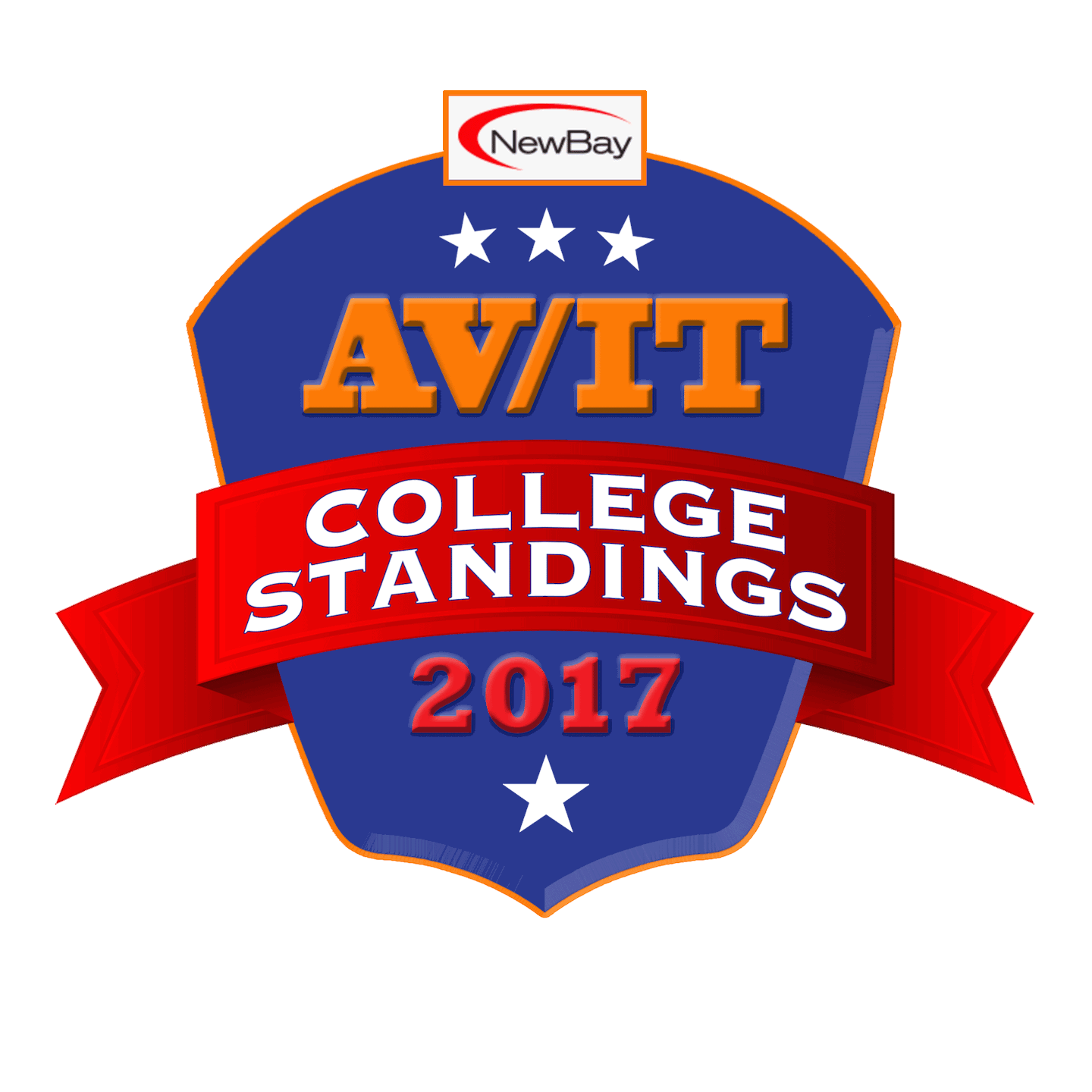Earlier this year, we welcomed our readers to our new campus–the digital campus of the new AV/IT College Standings program from NewBay Media. We are all used to seeing rankings of colleges according to their status in providing the “best” education for students, in broad terms, or in value terms, based on academic criteria. And we’ve seen evaluations of “technology schools” like engineering or computer science schools—with the focus on the quality or value of the tech degree conferred by those institutions. But why has there not been a closer curation of how a college or university uses technology in any school, department, discipline, or application, to help students, staff, or faculty have a richer learning/teaching experience?
We invited our readers to enter their best applications. The entries enthusiastically rolled in, from colleges and universities, and tech providers, offering a close look indeed at how colleges and universities are using technology today, with myriad details on the sophistication and usefulness of solutions for students, faculty, and staff. Nominations included details on collaboration, video, learning management, digital signage, and teaching technologies. These solutions are helping prepare students for success in the workplace of the future. We also saw entries involving learning spaces that are being designed to support peer-to-peer, collaborative, experiential, visual, service-oriented, and value-based pedagogies. These solutions offer new approaches to campus life on a fuller scale–addressing security, achieving diversity goals, recreational activities, and community and alumni participation.
This special section introduces the fruits of the program—the first curation of university solutions—by our readers combined with our invited judges. It’s not about ranking schools per se—primarily because pitting school against school goes against the spirit of university collaboration. Instead, this is about technology and pedagogy, not football. And because we are looking at individual applications, from individual departments or schools within universities, not evaluating the entire technology acumen or sophistication of a university as a whole. The intent is not an “Awards” program but a service to the community, to call out great new spaces and new applications in schools that can serve as an inspiration to all.
WHO SUBMITTED NOMINATIONS?
- College/University AV/IT managers, directors, admins, facilities managers, tech staff
- Technology Consultants and Integrators (with permission from the college/university)
- Architectural Design Firms
- Technology solution manufacturers (IT, AV, AV/IT, Learning Management System, Software, etc)
We then had our readers rank the entries, and asked a special panel of judges from the academic and university technology design communities to help us curate. We received more than 600 votes during the open voting period on our Open Water web platform.
Here are the main categories in which our readers entered their best applications, and a call-out to the best of the best:
BEST ACTIVE LEARNING CLASSROOM
• Top application: College of Lake County, Library Active Learning Classroom
• Application #2: Morgan State University, Earl G. Graves School of Business & Management Capital Markets Lab
• Application #3: Collaborative Classrooms at California State University, Fresno
BEST AUDITORIUM
• Top application: Florida International University, Student Academic Support Center Auditorium
• Top application #2: Clemson University, Watt Family Innovation Center
BEST DIGITAL SIGNAGE SOLUTION FOR STUDENTS OR VISITORS
• Top application: The University of Charleston Innovation Center
BEST FRESHMAN STUDENT ENGAGEMENT EXPERIENCE
• Top application: The Freshman Engagement Solution at Arts University Bournemouth
BEST HELP DESK
• Top application: College of Lake County Technology Help Desk: Student Centered Tech Bar
BEST HUDDLE SPACE
• Top application: College of Lake County, Library Huddle Spaces
BEST ATHLETIC ROOM AND/OR SPORTS STADIUM
• Top application: University of Oregon Hatfield-Dowlin Complex
BEST IMMERSIVE ENVIRONMENT
• Top application: Portland State University Decision Theater
• Application #2: University of Montevallo, HD Multi Operator Flypack Video Production Solution
• Application #3: American Sentinel University, Sentinel City College Health Simulation
BEST IN-CLASSROOM COLLABORATION ENVIRONMENT
• Top application: Duquesne University, 600 FlexTech Classrooms
• Application #2: Cal Poly’s Collins College Collaborative Classroom
BEST THEATER AND/OR LIVE EVENT SPACE
• Top application: Pensacola Christian College’s Eagle Mania Sports Center
BEST USE OF INTERACTIVE DIGITAL SIGNAGE IN A PUBLIC SPACE
• Top application: Clemson University, Watt Family Innovation Center Interactive Digital Signage
BEST COMMON SPACE (E.G. LIBRARY, STUDY SPACES, ATRIUM, CAFETERIA, LOBBY, OUTDOOR, ETC.)
• Top application: Morgan State University, Earl G. Graves School of Business & Management Atrium
BEST CLASSROOM AV/IT INTEGRATION
• Top application: Clemson University, Watt Family Center
• Application #2: Blue Ridge Community College AV Tools for Automotive Analysis and Repair Classes
• Application #3: Coastline Campus Systems for AV/IT Convergence
• Application #4: University of Nevada Las Vegas, Controlling 128 Classrooms at UNLV
BEST DISTANCE LEARNING SOLUTION
• Top application: University of Southern California, Preventive Medicine Soto Studio at the Keck School of Medicine
BEST IMMERSIVE ENVIRONMENT TECHNOLOGY SOLUTION
• Top application: Rush University, Center for Clinical Skills and Simulation
BEST LECTURE CAPTURE SOLUTION
• Top application: Florida International University, Active Learning Center
BEST OVERALL AV/IT CAMPUS INTEGRATION
• Top application: Syracuse University, Martin J. Whitman School of Management Active Learning System Across Campus
• Application #2: Azusa Pacific University, IMT Media Services Broadcasting and Event Integration
• Application #3: University of Nevada Las Vegas, Enterprise AV/IT System to Support Classroom Technology
• Application #4: Oklahoma State University, Human Sciences Building
BEST STREAMING MEDIA SOLUTION
• Top application: The Super Lab, at the University of Technology Sydney (Australia)
BEST TECHNOLOGY SOLUTION THAT HAS INCREASED FACULTY ENGAGEMENT
• Top application: University of Scranton Standardized Campus AV for Instructors and Staff
BEST TECHNOLOGY SOLUTION THAT HAS INCREASED STUDENT ENGAGEMENT
• Top application: Duquesne University, Anatomy Lab Video Systems
• Application #2: Humber College Mobile Usability Testing Lab
BEST STREAMING MEDIA SOLUTION.
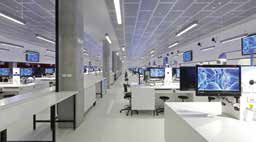
Application: The Super Lab, at the University of Technology Sydney. The Super Lab is a collaborative parallel learning space with over 200 student positions where students can discover other scientific disciplines and mix with students from other year groups. The idea is for students of all years to see what is occurring and possible, and to spark the imagination on how to cross disciplines. By integrating a strong AV component, the Super Lab will allow materials to be easily shared, questions to be passed to the entire or isolated groups, and exploration to occur freely across the entire facility. Each student seat has an HP all-in-one touchscreen computer on an articulated arm that receives the live-streamed lecture(s) encoded by 12 Matrox Maevex encoders (one for each teaching position). The content distributes through a Crestron switcher to the students’ computers where the streams are decoded via VLC. There are no speakers in the room; audio is via Sennheiser wireless headphones served through BSS DSP and a Williams Sound infrastructure (we’ll come back to that). The teacher has a lectern’s worth of equipment accessed through a simple app-driven, drag-and-drop Crestron XPanel interface. To begin teaching, they use the panel’s graphical floor plan to select which seats they will send live video to. All audio and video will be automatically directed, including the wireless audio from the teacher’s Sennheiser beltpack. Teachers can also feed content from the internet, a memory stick, document camera, or mobile device. (They can also access twelve 65-inch NEC wall-mounted LCD screens to display any content in real time.)
BEST CLASSROOM AV/IT INTEGRATION.
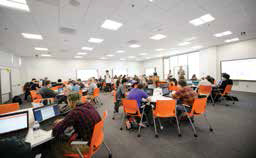
Application: Clemson University, Watt Family Center. The Watt Family Innovation Center (Watt Center) is a new facility at Clemson University that embodies key tenets of 21st century education including problem-based, cross-disciplinary learning through use state-of-the art technologies and facilities. Rather than being aligned with a particular school, college, or institute within the university, the Watt Center supports academic, research, and public service activities that literally cut across the campus. The Watt Center plays host each week to over 4000 students who are enrolled in 60 different classes offered by 26 different departments at Clemson. Designed with the General Engineering program in mind, rooms 106 and 208, shown here, serve primarily as two of the locations for introductory engineering courses for freshman before they declare a specific concentration in engineering. The rooms are extremely conducive for students to be able to break out into teams to collaborate on solving problems. The rooms are equipped with circular white board tables and windows that enclose the classrooms and are used as white board so that students can work through problems by hand and share with the class. Planar touch displays enable the instructor to show their content or enable the students singularly or in teams to connect and present their own content via Wi-Fi through Solstice software. This quickly stimulates discussion and progresses the experienced-based learning. The 98-inch Planar LCD’s are incredibly useful and versatile for a classroom environment, as they are touch-enabled and possess 3-D capabilities that allow a higher degree of interaction between students and instructors. As well as facilitating the AMX SVSi by Harman switching for them at the podium, we have also placed Crestron panels at the door and use it for scheduling the room when not in use. Students can stop at the door, see what is planned for the day and schedule open slots for collaboration with their own group.
BEST CLASSROOM AV/IT INTEGRATION
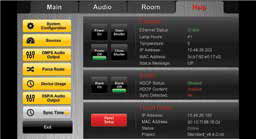
Application: University of Nevada Las Vegas, Controlling 128 Classrooms at UNLV. UNLV population has approximately 28,600 students on 332 acres just 1.5 miles from the Las Vegas strip. There are 173 general purpose classrooms included in the total count of 359 learning spaces across campus supported by Classroom Technology Services. There are 173 general purpose classrooms included in the total count of 359, with 128 classrooms monitored. UNLV has created a single touch panel program that serves 95 percent of the Crestron controlled classrooms. The driving factors involved were to create a simple and reliable system, allow for ease of troubleshooting, equipment replacement, and incorporation of suggestions from the faculty. This program allows Classroom Technology Services to be able to easily deploy pre-programmed systems with the ability to dynamically make adjustments or customizations necessary for the individual room. The configuration options are in a secure tech page on the panel accessible through the Help tab. After logging in, the panel shows the current state and technical information of the room, including statuses of the projector, scaler, and touch panel itself. On the left, you have the choice of System Configuration, Sources, DMPS Audio configuration, and XSP/A Audio sub-menus to access the customization options. You can also view how often the system and sources are being utilized through the Device Usage submenu.
BEST IMMERSIVE ENVIRONMENT TECHNOLOGY SOLUTION
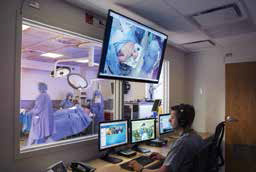
Top application: Rush University, Center for Clinical Skills and Simulation. Rush University Medical Center has opened the last phase of its new, state-of-the art simulation lab, the Rush Center for Clinical Skills and Simulation (RCCSS) to provide updated technology and additional space where students and medical providers could all train together. The new lab includes three simulation rooms equipped with manikins that emulate the anatomy and physiology of actual patients. It also includes debriefing rooms, a smart classroom and a patient care area. The smart classroom is where trainers teach skills such as inserting an IV or spinal tap, and more complex procedures such as laparoscopic surgery. The smart classroom technology includes an Epson BrightLink 595Wi interactive finger-touch projector and a Da-Lite IDEA glare and hot-spot free whiteboard. Unlike traditional interactive whiteboards, the BrightLink and IDEA board allow trainers to use the space to annotate on slides, diagrams and stop motion video—and then record and save these annotations so students can watch the presentation as they study. The classrooms also include movable tables and chairs. The center also has four debriefing rooms with large video monitors connected to the audiovisual system allowing students and instructors to review and discuss the video of the scenarios. The simulation center also includes a smart classroom and a patient care area.
BEST ACTIVE LEARNING CLASSROOM
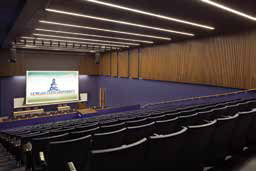
Application: Morgan State University, Earl G. Graves School of Business & Management Capital Markets Lab. Morgan State University, Earl G. Graves School of Business & Management Capital Markets Lab. Keeping up with the latest technologies, the University continues to evolve and is quickly expanding its capacity as an institution for higher education. A great example of the University’s commitment to forward thinking is their newly built Earl G. Graves School of Business & Management. It’s an impressive $72-million state-of-the-art facility that represents innovation with cutting-edge technology installed in every space, hall and classroom. The facility has served as a great tool to support outreach efforts in attracting the top students and faculty across the nation. Their main goal has continually been to create a world-class environment second to none, while supplying their faculty with the tools they need to teach at a higher level and provide their students with opportunities to excel on a global stage. Digital Projection’s Titan Quad 16,000 Lumen DLP Projector provides large-scale imaging for the auditorium. Crestron is the control platform used to integrate all of the auditorium equipment.
BEST IN-CLASSROOM COLLABORATION ENVIRONMENT
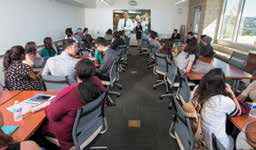
Application: Cal Poly University’s Collins College Collaborative Classroom within Collins College Hospitality Management (CCHM). CCHM in Pomona, California, was founded in 1973 as the first such institution in California, and is the largest in the state. Their Master of Science degree program is ranked as one of the top 10 hospitality and tourism graduate programs in the country. To support its burgeoning enrollment, CCHM built the LEED Gold certified Building 80, named the Marriott Learning Center. It is designed to shape student behavior in hospitality management through the use of natural lighting, open spaces, and advanced technologies. The new 12,100 square foot facility includes lecture halls, group and graduate study rooms, a videoconferencing suite, and various meeting rooms. For social gatherings, courtyards offer vistas of the surround rolling hills while the Student Commons, cafe, and lounges feature campus-related content and entertainment on flat panel displays. Each area has a dedicated AV system with distinctive capabilities. The staff at ClearTech Media designed a wide variety of AV systems using Extron ShareLink Series wireless collaboration gateways, the IN1608 scaling presentation switcher, XTP Systems, and TouchLink Pro Series controllers.
